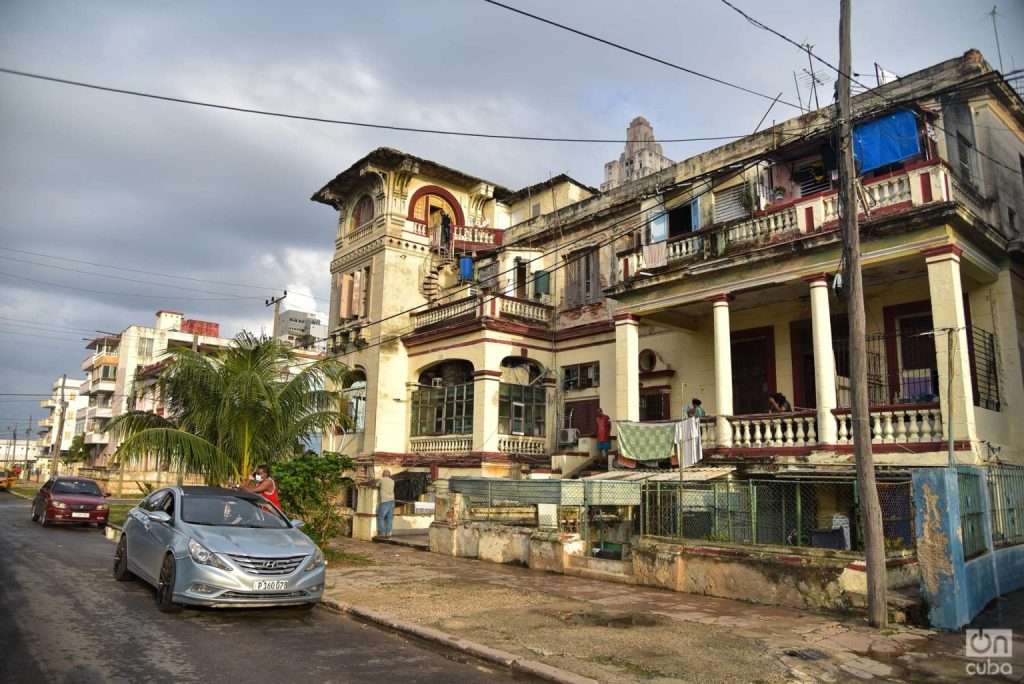The recent evolution of the city of Havana, fragmented, disjointed and disorderly, without clear and agreed objectives, is worrisome.
Each acting subject — public administrators, businesspeople, citizens…. — carries out transformation actions without evaluating or taking into account their effects on the urban planning as a whole.
This lack of coherence is very costly for the city: it generates inefficiency in the use of land, deteriorates the environment, mistreats the urban landscape, causes unnecessary expenses and promotes social and territorial inequalities.
It would seem that correcting such problems requires a plan that guides and coordinates growth and transformation. But everything indicates that it is a necessary but not sufficient condition. Just look at the fate of previous plans.
They have been formulated one after the other to be invariably ignored and forgotten. We cannot continue doing the same thing if we want to obtain different results.

Not only the goals, but also the path
The issue is that it is not enough to formulate general principles and design objectives to be achieved. Ackoff proposed the briefest and most precise definition of what planning is: “defining objectives and the path to reach them.” It is not enough to state desires, it is necessary to conceive and propose how to achieve them.
It may seem like a truism to say that a plan is formulated to be executed, but harsh and implacable reality shows us that this is not the case. Most have not been fulfilled.
Lessons from the past
It would be an absurd and sterile exercise to continue making plans without first drawing some lessons from what has happened with the previous ones.
Executing the plan requires the existence of many other factors. I will try to show those that, in my opinion, are essential and that, if they are not dealt with in a timely manner, make any planning action useless.

- Need for assessing studies of previous planning and execution.
It is essential to carry out a double analytical and self-critical exercise on compliance or non-compliance with the decisions of the current plan and on what has actually been carried out in recent years.
It may be, for example, that the plan determines that the rehabilitation of the existing housing fabric is a priority, avoiding new peripheral growth, but that, on the contrary, all public housing construction initiatives have been carried out in these external areas, occupying new territories and forcing an expensive extension of the urban infrastructure. Why was that? Was it inevitable?
At the same time, it is necessary to analyze what has been the logic of the sectoral plans and the investment process — both public and private — and what factors have influenced the real transformations of the city and not others.
It is unavoidable, for example, to critically examine the results of recent urban operations such as the program for the 500th anniversary of the capital, the action program dedicated to vulnerable neighborhoods, the hotel program, the MINFAR housing neighborhoods, or the impact of investments generated by new private ventures, identifying trends, opportunities and threats.
It will also be necessary to examine the reasons why so many subjects — state or private — ignore in practice urban regulations and bypass established procedures.
And the analysis must be objective and unbiased because it is possible that the one that is wrong is the plan or that the regulations are not enforceable in the current circumstances. Is it about indiscipline of the executors or insufficiencies of the planning? Or both?
Nor can one ignore the abundant studies and research carried out by various university faculties (Architecture, Economics, Geography, Law, Sociology….) that already cover many areas of the city.
When viable proposals have been conceived and designed, articulation with governments has not been easy. Also important is what has been produced in the Science, Technology and Innovation Entities (ECTI) or the proposals for collaborative projects, difficult to coordinate and agree with local governments.

- Updating regulations and urban approaches (concepts).
In order to formulate the plan, it is necessary to have updated urban regulations that set the standards of level and quality of life that must be foreseen.
The country has changed enormously both from the demographic point of view (aging, small families….) and social and economic aspects.
It is necessary to know what habitability regulations (m2 of housing per family) should be applied, what should be the levels to be achieved in the provision of urban facilities (daycare centers, schools, polyclinics, shops, etc.), what minimum or maximum densities of land occupation and buildability, what surfaces of green and sports areas, etc.
As is obvious, they must be regulations related to the real economic and technological capacities and to the social and cultural characteristics of the city.
On the other hand, technological and cultural changes inevitably affect the approaches and priorities when designing urban transformations. Two concerns stand out, for example, in the new conceptions: social inclusion and sustainability.
Concepts such as the 15-minute city or the superblocks advocate a more equitable distribution of employment, services and green areas that improve the quality of life in the neighborhood, balance the city and, with it, reduce the demand for transportation.
At the same time, a growing sensitivity to environmental problems and climate change calls for a renaturation of the urban fabric (less cement, greener, more shade, less heat….) to improve the environmental quality of the city and increase its resilience (ability to recover) in the face of climatic threats. Something very necessary in Havana where a real war against trees seems to have been declared.
The analysis of urban metabolism (flows of materials, energy and information that allow the identification of environmental and social impacts) and the concern for sustainable development (urban regeneration, renaturation, waste management, renewable energies, digital technologies, urban participation….) are the focus of many of the current concerns of urban planners, which should not make us forget the capital’s two priorities: housing and transportation.

- An updated, comprehensive and computerized database.
It is essential to have adequate information so as not to act blindly. It is necessary to territorially integrate a multitude of sectoral data from various agencies, in particular a decisive aspect: that referred to land management.
It is a priority, for example, to know where the idle land is and to whom it belongs in a city that intends not to grow any further. All the partial assessments indicate that it is a very “porous” fabric, with numerous lots little or not used at all. The calculations suggest that the city can absorb any prospective growth in its own municipalities (including Centro Habana).
It is essential to accurately quantify and locate those unused areas in order to make them available to the city. The same thing happens with the land built on. It is unfortunate to see the degree of overcrowding in many residential buildings, tenement houses and hostels and compare it with the size of numerous offices, warehouses and business and administration premises where there are obviously too many square meters or are even closed. In many cases, they are old, adapted dwellings.
In these circumstances, it is vital to speed up the completion of the urban cadastre, to know the use of urban land in detail and to develop legal and fiscal mechanisms that encourage better use of the land that, after all, constitutes the main asset of the city. For example, data that is not published or analyzed today is essential, such as that accumulated in notaries, referring to real estate sales, or in property registries. This would help to understand real estate market trends and adjust regulations accordingly.
It is also essential to update the 2011 Population and Housing Census in a city with an intense migratory flow from the provinces to it and from it abroad, which has undoubtedly generated profound sociodemographic changes in the last twelve years.

- An appropriate institutional structure and management style.
The city requires a group not only for planning but also for managing the plan that is able to coordinate the actions of 15 municipalities, the three levels of administration (national, provincial and municipal) as well as the many ministries.
An authority with sufficient political power is necessary to be able to dialogue and, if necessary, confront ministerial interests and those of the central level to defend those of the city. In this sense, the elimination of the Assembly of Delegates at the city level in the case of Havana does not help either.
How to harmonize and articulate the different development strategies elaborated by the fifteen municipalities?
How to determine what in one municipality is complementary in another?
How to solve problems that are not solvable at the scale of the Havana municipalities — infrastructure networks, public transportation, just to mention a few aspects, if the border between them is a street — to top it off, many times the axis of the street — with very few differences between one sidewalk and another?
An essential issue is the decentralization of institutions. There is a paradox that various agencies — such as the Institute for Territorial Planning and Urban Planning or the Ministries of Science, Technology and the Environment, of Tourism or of Agriculture — maintain vertical structures with provincial delegations at the same time that they transfer numerous powers to the municipalities without accompanying them with the human, material and technological resources necessary to be able to comply with those attributions. Today these are very weak entities, not only in planning tasks but also in inspection and control.
Without a reinforcement of these local instances, urban planning is almost impossible, if not useless.
Another decisive issue to resolve is the inability of government entities to think strategically and generate the appropriate structures. The government wears itself out putting out “fires” without being able to prevent and avoid fires. The urgent supplants the important, compromising the future.
Frequent exhausting and ineffective tours are carried out in which solutions are improvised “by hand,” without taking into account studies, economic analyses, plans and expert opinions, only to later have to “pull out.” It seems that the cadres are specialists in making decisions on any matter.
It is necessary to examine whether it is not necessary to give a differentiated treatment to the capital, which is not a mere sum of municipalities.
It would be important to study the different forms of management of capitals in other countries — Federal Districts, Metropolitan Areas — as well as their internal political-administrative division.
The municipality of Santiago de Cuba, which contains a city of almost half a million inhabitants and a territory of more than a thousand km2, cannot be treated the same as the municipality of Old Havana, for example, with its four km2 and 80,000 inhabitants.

- Mechanisms to create a city’s own investment budget.
The city’s main asset — its built and unbuilt public land — is today in the hands of the sectoral administrations — the ministries, their delegations and enterprises — and is managed by them. The city decides almost nothing on this matter, and it is important for it to regain control.
The supposed comparative advantage of Cuba, in terms of the fact that the majority of urban land is publicly owned, vanishes in the face of the reality of that non-territorial but ministerial administration. The city would need to be able to establish a land bank on a metropolitan scale to be able to really direct its development and transformation.
A reform should also be carried out that would expand urban taxation — taxing, for example, idle land — and expanding rates and contributions that are currently absolutely insufficient (such as 1% of the land tax).
The city must manage its taxes and provide itself with a budget that is up to the challenges it must face. This is one of the reasons for the urgency to complete the urban cadastre and the valuation of real estate (since it constitutes the tax base). How to tax a land that you don’t know how much it is or who it belongs to? Today, the footage corresponding to each owner, whether state or private, is still unknown, and therefore the value of these properties is unknown.
It is not about raising the tax burden for all citizens but for those private owners or state owners who exceed certain limits. Instead, it would be about forcing large investors to contribute in some way to the financing or construction of social housing or technical infrastructure (as is done all over the world).
Today it is surprising to observe how, in Havana, new and luxurious hotels are inserted in very deteriorated urban fabrics without contributing anything at all to their improvement.
This leads us to insist that it is essential to introduce economic analysis in territorial decisions. I am not aware of an urban plan for the capital that has made a comprehensive assessment of the resources necessary to carry it out.
What feasibility can a plan have with these gaps? The planning is done as if the economic dimension did not exist, which allows formulating any aspiration as legitimate and achievable. It is true that the current monetary and exchange rate chaos does not facilitate such calculations, so as long as inflation is not controlled, and the currency is unified, other ways of providing the plans with a minimum of realism will have to be found.
The city also has other economic potentials that are used throughout the world for public benefit. They may seem like intangible, non-material values, but they are absolutely real and can be transformed into monetary values.
I am referring to the location (a plot in the center cannot have the same value as that in the periphery); urbanization (an already urbanized plot is not the same as one to be developed); or buildability (a plot on which only two floors can be built does not have the same profitability as one on which 20 can be built). These are economic realities that should not be ignored and whose value can be put at the service of the city.

- A real political will.
Last but not least, the essential condition for a plan to be useful is that behind it there is a government that is aware of its need, as well as an administration and citizens that understand that the plan can make compatible and harmonize conflicts, save resources, articulate investments and, ultimately, raise the quality of urban life.
If the plans become academically impeccable documents, but popularly incomprehensible; if they do not respond to the concerns and questions asked by the local government; if they do not become instruments that guide businesspeople, the effort is not worthwhile.
It is necessary to adjust the correlation of forces and achieve the necessary balances between needs and possibilities, between the short and long term, between private and public interests, between efficiency and social justice, between what is urgent and what is important. It is necessary to know and be able to translate the design not only into a physical (constructive) but also a legal (contracts, agreements, tenders….) and financial (burdens, incentives….) reality.
I will leave pending, for now, a controversial aspect that is difficult to solve throughout the world: finding adequate mechanisms for the participation of citizens and civil society in the formulation of the plan or, at least, in the definition of priorities.
A strong sense of co-responsibility would have to be achieved, but this implies at least two factors: information and training. Without adequate public information and without minimal training on the subject, participation becomes an attractive but manipulative discourse, in fact an alibi to do what has already been decided.
It will be necessary to begin by exploring already existing ways that are not being used adequately: for example, the possibilities offered by current technologies for public consultations and the dissemination of content are considerable, as well as legal regulations already promulgated and not applied in practice, such as the exercise of participatory budgets. It is true that as a team progress is slower, but further is gone….
In summary, my personal answer to the initial question is yes, Havana needs a plan, but not just any plan, nor under any condition.
If progress is not made in terms of political will, urban budget, institutional strengthening, database, updating of regulations and capacities for realistic and self-critical analysis, the effort is not worthwhile. The plan may even become a pretext to continue doing more of the same. And these are not the times for it.











